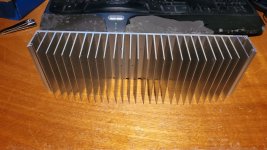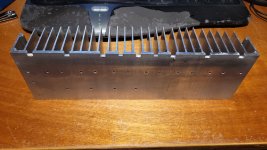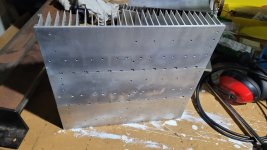Yes, it's not unusual to do. Of course, it isn't always possible to put extensions in the ideal place, so make sure you underrate if a 'wing' is separated by more resistance than would be best.
Thermally it would be better to arrange them in such a way to have as much cool air as possible flowing through the cooling fins, thus not on top of each other. But for a single heat source it's probably better to arrange them as compact as possible.on top of each other
Doubling the heat sink, fin length, size doesn’t halve the C/W it only reduces ~70.7%.

I'd think bolts and paste. Structurally more secure and the thermal conductivity of the paste would be better from what I've read paste can be up to 2x the conductivity of glue. The more bolts the merrier I'd think because they'll also get heat directly into the heatsink and ensure contact between plate and sink is as good and even. Might be a good idea to use aluminium bolts too so they expand and contract at more or less the same rate as the material they're holding together. Or were you planning on drilling through the sink and using locking washers?
Also worth considering the different coefficients of expansion of differing alu alloys?
Will the output transistors be arranged 50/50 on each side of the board? So each sink could get the same heat input? If so, would it be worth just bracketing the sinks together to keep them mechanically stable? Half the heat goes to one sink, half to the other?
Also worth considering the different coefficients of expansion of differing alu alloys?
Will the output transistors be arranged 50/50 on each side of the board? So each sink could get the same heat input? If so, would it be worth just bracketing the sinks together to keep them mechanically stable? Half the heat goes to one sink, half to the other?
If you are using a plate to mate them, try to get 5mm copper, not alminum. It will spread the heat much better than aluminum. You need not cover the whole surface with it, depending on the semi's you fix you can leave some space on top and bottom.
Be sure to leave a tiny gap like .3 mm between the heatsinks, otherwise the construction may bend when heated.
Use good, clean (!) thermal paste in a thin layer, not too much. You should use large washers under the screws pressing the parts together and not over tighten them.
Better to let them set over night and then repeat next day as the paste will still move.
Be sure to leave a tiny gap like .3 mm between the heatsinks, otherwise the construction may bend when heated.
Use good, clean (!) thermal paste in a thin layer, not too much. You should use large washers under the screws pressing the parts together and not over tighten them.
Better to let them set over night and then repeat next day as the paste will still move.
No really, its only a few ppm/C, more important for very different materials like steel/aluminium, though even copper and aluminium are pretty well matched for this kind of use. If only diamond was a practical material for heatsinks, almost no thermal expansion and extremely good thermal conductivity...Also worth considering the different coefficients of expansion of differing alu alloys?
Surely the taller the heatsinks, the more the chimney effect, and more "draw"; the top one might be receiving hot air, but all of them would be receiving more air. Plus there's be more thermal storage and they'd look cool. Plus more area to radiate heat.
Short answer is yes, but there will be some thermal resistance between the interfaces (where metal parts contact) so surfaces need to be as flat as possible with conducting paste - check out metal based pastes for computer CPUs.
You will end up with slightly more heatsinks than the equivalent single piece heatsink.
You will end up with slightly more heatsinks than the equivalent single piece heatsink.
That's roughly what I thought.Short answer is yes, but there will be some thermal resistance between the interfaces (where metal parts contact) so surfaces need to be as flat as possible with conducting paste - check out metal based pastes for computer CPUs.
You will end up with slightly more heatsinks than the equivalent single piece heatsink
Not as efficient as a proper large heatsink but I happen to have a bunch of these onkyo heatsinks and proper heatsinks are not available in NZ. They require bringing in for overseas.
My evil plan is to graft 6 of them together to make 2 monster heatsinks as per the photos. I'd expect them to weigh at least 3.5kg as the individual heatsinks are 0.9kg. This should be more than enough for my wolverine monoblocks build when I eventually get there.
- Home
- Design & Build
- Construction Tips
- Grafting Heatsinks together



